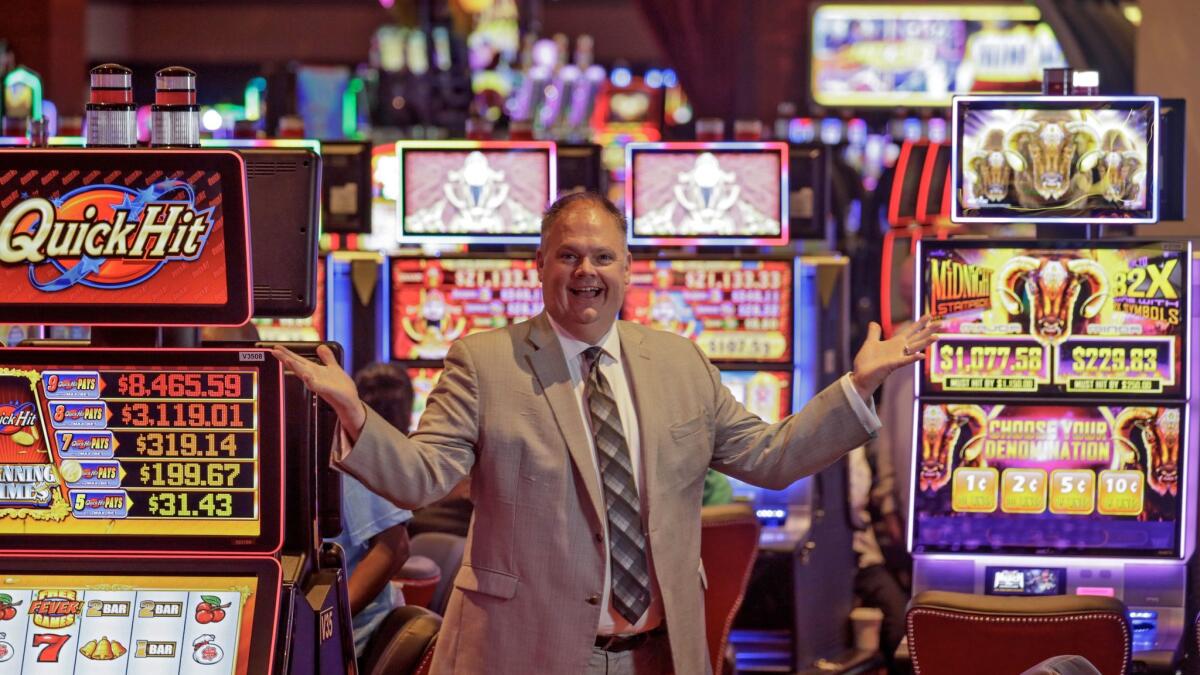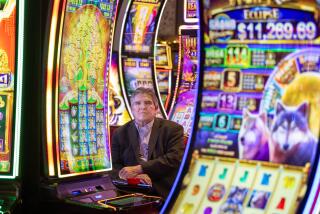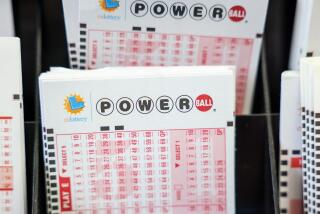Rock ‘n’ roll and slot machines replace bingo at the San Manuel Casino

The San Manuel Casino has traded in its bingo cards for something more electric.
Bingo, once the primary revenue source for the San Manuel Band of Mission Indians in San Bernardino County, has been phased out at the casino, near Highland. What had been the nation’s second-largest bingo hall is now filled with hundreds of new slot machines, card tables and a loud rock ’n’ roll-themed restaurant.
The revamp and expansion is part the casino’s effort to dominate the gambling scene in Southern California by adopting a younger, more energetic vibe. The tribe said it plans to spend another $550 million to build a 500-room hotel adjacent to the casino.
“We are not here to be also-rans,” said Loren Gill, the casino’s general manager. “We are here to be the best.”
But the competition will be tough. Other casinos around the region have already invested heavily in upgrades to take advantage of surging consumer confidence, which has brought in a steady stream of gamblers willing to lay down big bets.
The Bicycle Casino in Bell Gardens unveiled a new 99-room hotel last year.
The Pechanga Band of Luiseño Indians plans next month to open a $285-million project that will add a 568-room hotel wing, plus a two-story spa and other amenities to its casino in Temecula.
The Pala Casino in northern San Diego County has completed a $5.7-million renovation that included a new wine cave and an outdoor patio lounge.
The investments make sense. Gambling revenue at Indian casinos in California grew 8% in 2015, compared with 4.6% growth in 2014, according to a report by Alan Meister, a gambling-industry expert with the consulting film Nathan Associates.
California leads the nation with 63 tribes that run gambling operations. Revenues from those operations in 2015 — a record $7.9 billion — represent the sixth straight year of growth since the economic meltdown, according Meister’s report.
“The strong growth in recent years has encouraged further development of existing gaming facilities,” Meister said in a statement. “As some casinos expand and renovate, competitors may need to look to do the same in order to maintain market share and grow.”
Since October 2016, the San Manuel tribe has added 900 slot machines, 16 card tables, a daiquiri and juice bar and a Mexican restaurant designed by comedian George Lopez, plus overhauls of its steak restaurant, retail outlet and an Asian-themed gambling room.
The most noticeable change has been the expansion of its Rock & Brews restaurant, a raucous rock ’n’ roll-themed eatery founded by, among others, Gene Simmons and Paul Stanley, members of the rock band Kiss. It serves bar food among rock images and giant television screens on the wall, blaring concert footage and music videos.
Like most of the other casinos that have invested in upgrades and expansions, the San Manuel Casino is making a play for younger gamblers with a more lively atmosphere, Gill said. That meant eliminating more geriatric games.
“We are out of the bingo business,” he said.
The San Manuel Indians jumped into gambling in 1986 with a 50,000-square-foot bingo hall, the nation’s second-largest bingo operation. Over the years, slot machines and card tables have taken over bigger shares of the casino.
In place of the last 25,000 square feet of bingo-devoted space, in addition to the expansion of the Rock & Brews restaurant, the casino added a merchandise shop, a new bar and the final 400 of the 900 new slot machines.
Gill said the bingo parlor could not match the surging demand for the slot games, hot wings, barbecue chicken and jalapeño poppers. The casino has been drawing a maximum of about 1 million visitors a month since the upgrades were completed, but Gill declined to say how much numbers have increased in the past year.
Hoping to take advantage of the growth, the tribe plans to spend about $550 million on a hotel with 500 rooms, a spa, pool and five new restaurants. Gill said he hopes to break ground next year with the opening scheduled for 2020.
The expansion is expected to employ 1,400 construction workers and add about 1,200 full-time jobs, bringing the casino’s staff to about 5,000 employees.
On a recent Tuesday afternoon, the casino was alive with the sounds of slot machines ringing and gamblers shuffling between games.
Monica and Albert Amador of Fontana sat at one of the casino bars, eating French fries and playing video poker. The couple said they visit the casino about once a week to eat.
“The food is amazing,” Monica Amador said.
The couple live only a few minutes’ drive from the casino, but once the tribe completes its hotel they said they might book a room or try the new restaurants.
“That’s another reason to come,” she said.
But not everyone is happy about the changes at the casino.
Josie Alarcon, a retiree from San Bernardino, said she she misses the bingo, which she played almost daily in the past. Now she gets her fix at the bingo halls at the Pechanga Casino or the Morongo Casino in Cabazon, she said.
Asked about the changes at the San Manuel casino, she shrugged and said: “It’s OK, but it’s not the same.”
To read more about the travel and tourism industries, follow @hugomartin on Twitter.







